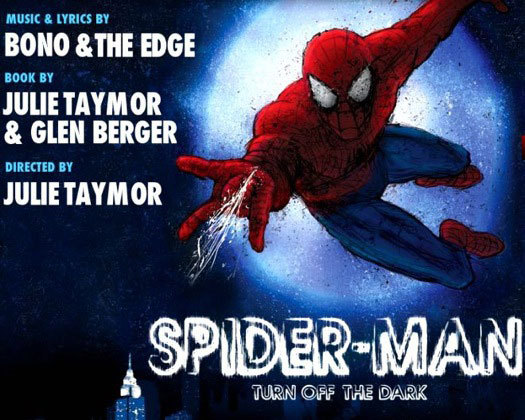
Last week I was treated to a preview performance of Spider-Man: Turn Off the Dark, My benefactor was Goldstar, an entertainment company that donated tickets to New Yorkers affiliated with the TED conference, including press.
Although I sing the TV theme song to children in a pitiful bid to win their respect, I’m no particular Spidey fan. I was happy to go anyway. Directed by the irrepressibly imaginative Julie Taymor, with sets designed by George Tsypin, who, like Taymor, is known for elaborate stage concoctions, Spider-Man is notorious for costing more ($65 million) and being in previews longer (four months) than any show in Broadway history. The need to engineer a theater to support its acrobatics has meant that Spider-Man’s kinks have been smoothed out in full view of the New York press. Mishaps have included injuries of a few cast members, one who plummeted 20 feet when his safety harness proved to be untethered, another who broke both wrists in attempting to land on a mezzanine platform after swinging over the orchestra section, and a third who suffered a concussion from being struck by an errant cable. Some preview audience members have reportedly confessed to going simply for the thrill of witnessing the next casualty, but I wasn’t in it for the bloodshed. I just had to see what kind of production design justified that kind of pain.
Spider-Man is meant to wow people who have grown benumbed by multiplexes and Xboxes. After sitting through two dozen aerial stunts, accompanied by a score with a U2 pedigree, and by something that might be described as a plot, I emerged astonished by only one thing: that no one has actually died while making this musical. Yes, the design is impressive. Row houses aligned in front of the 59th Street Bridge in Queens grow, shrink and change orientations as the characters approach. A mad scientist haplessly rotates in a Orgasmatron-like sphere before turning into a giant green lizard. The Chrysler Building sprouts from the earth turns on its side and treats the audience to a dizzying perspective of the street “below” (i.e., projected onto the rear wall of the stage), while Spidey and the Green Goblin, who are strung on wires, swoop and wrestle in the theater’s vast open space.
“We tried to make a pop-up book come alive,” the assistant scenic designer Rob Bissinger told my group at a pre-show gathering. “The set comes out and embraces the audience like a lover’s kiss.” Spider-Man felt less like a kiss than an assault with a BB gun spraying random bits of comic book, art, film and Broadway musical history, from West Side Story and His Girl Friday to Nam June Paik. The last was echoed in towers of video screens with beautiful projections designed by Kyle Cooper. Those projections — a gritty montage of Spidey’s enemies — may be the most compelling part of the show, and how ironic is that? Spider-Man is a laborious attempt to exploit the value of live action in three dimensions, breaking the fourth wall with flying bodies and mechanical scenery.
Unfortunately, that is the only place where this show respects dimension. Spider-Man: Turn Off the Dark relies on comic-book-style exaggeration in everything, leaving a talented cast floundering, except in the parts when they get to show off their aerial grace. The story is adopted from Marvel, mixed unsuccessfully with Greek mythology and saddled with a contemporary framing device. It’s leaden and, at parts, incoherent. The characters are so flat they make Archie look like Chekhov. Bono and the Edge gave the score a relentless, hard-driving sameness; even lyrical ballads quickly turn into power-pop wails.
Live theater’s value is that it offers intimate character portrayals and audience connections. Even a comics tale can bruise your heart, as Spider-Man should with its story of a nerd who manages to get the girl yet struggles to hold her because he’s busy performing secret heroic deeds. But Taymor, our Busby Berkeley, subordinated emotion to the power of hyperactive spectacle, which is what theater has been ceding more and more to digital video effects and screens. After the show, I dug Spiderman 2 out of my DVD collection and watched it for the first time. It was all there: modest Queens row houses, flying bodies and sparks, fantastic creatures, epic battles and skyscraper-top perspectives. Plus Tobey Maguire. No contest.
Live theater can still be visually astonishing, even in translation from other media. Consider the recent Kneehigh Theatre production on Broadway of Brief Encounter, which like Spider-Man made use of video projections and onstage musicians to adapt one of civilization’s silliest romance stories for the stage. It was beautiful and moving. Or consider Gatz, a verbatim reading and enactment of The Great Gatsby. Produced with a budget so meager that the show’s creators, Elevator Repair Service, later hit up the audience for donations, Gatz managed to produce the illusion that a single set — a shabby business office — was also a Long Island mansion and cottage, a gas station, a restaurant, a sweltering Manhattan apartment, etc. etc. And guess who was sitting two rows in front of me during the entire six-hour performance? Tobey Maguire. My superhero.


Comments [2]
And I'm mighty mighty
And I fighty fighty
For what's righty righty!
02.01.11
02:14
02.01.11
05:53